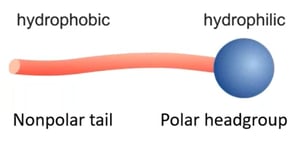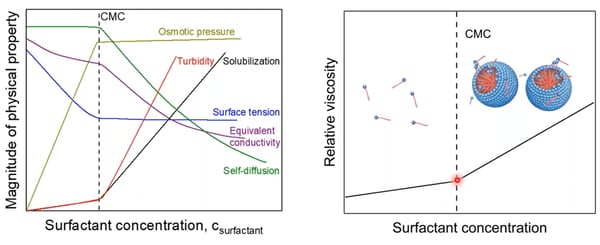Amphiphilic molecules have hydrophobic (e.g., surfactant non polar tail) and hydrophilic (polar headgroup) regions.

As we have mentioned in our previous blog, the critical micelle concentration (CMC) is the concentration of surfactants above which micelles form and all additional surfactants added to the system will form micelles. A variety of common molecules form spherical micelles including surfactants, multi-block polymers, and certain types of proteins.

CMC is affected by things such as temperature, charge on surfactant headgroup, presence of any salt added to the system, pH, and even the solvents you use (water vs. glycerol or other solvents).
Many physical properties of solutions will show an abrupt (dramatic) change at the CMC. Viscosity is one of those properties, which allows us to utilize viscosity measurements to calculate the CMC of your solution by determining this abrupt change. A challenge in determining CMC is the low sensitivity of these properties. VROC® viscometers can be used to measure viscosity of these solutions to help determine CMC because of the high sensitivity, high throughput, and small volume capability of our technology.

Casein is the main protein found in milk and also the primary reason milk has it's recognizable white color. Casein molecules aggregate into sub-micelles which then come together and aggregate into a large casein micelle. Casein micelles are stabilized by calcium phosphate. When calcium phosphate is removed, the casein micelle will disassociate into individual proteins, which are insoluble in water. To get these proteins to dissolve, or "re-dissolve", you can add sodium hydroxide to your solutions creating a product called sodium caseinate.
Sodium caseinate can be used in low concentrations to change the texture of foods (such as coffee creamer, cheese and ice cream). Characterizing these sodium caseinate micelles is important because they affect the rheological properties of the solutions they are in.
In our webinar "Monitoring Self Assembly in Complex Fluids with Viscosity", a full intrinsic viscosity or dilute concentration series analysis of sodium caseinate is reviewed, illustrating how the intrinsic viscosity parameter can be combined with the protein molecular weight to estimate the hydrodynamic radius and volume fraction of the sodium caseinate micelles.
 Download the webinar to learn more
Download the webinar to learn more
Written by: Chrystian Ochoa, PhD, RheoSense Applications Scientist and Eden Reid, RheoSense Senior Marketing and Sales Operations

